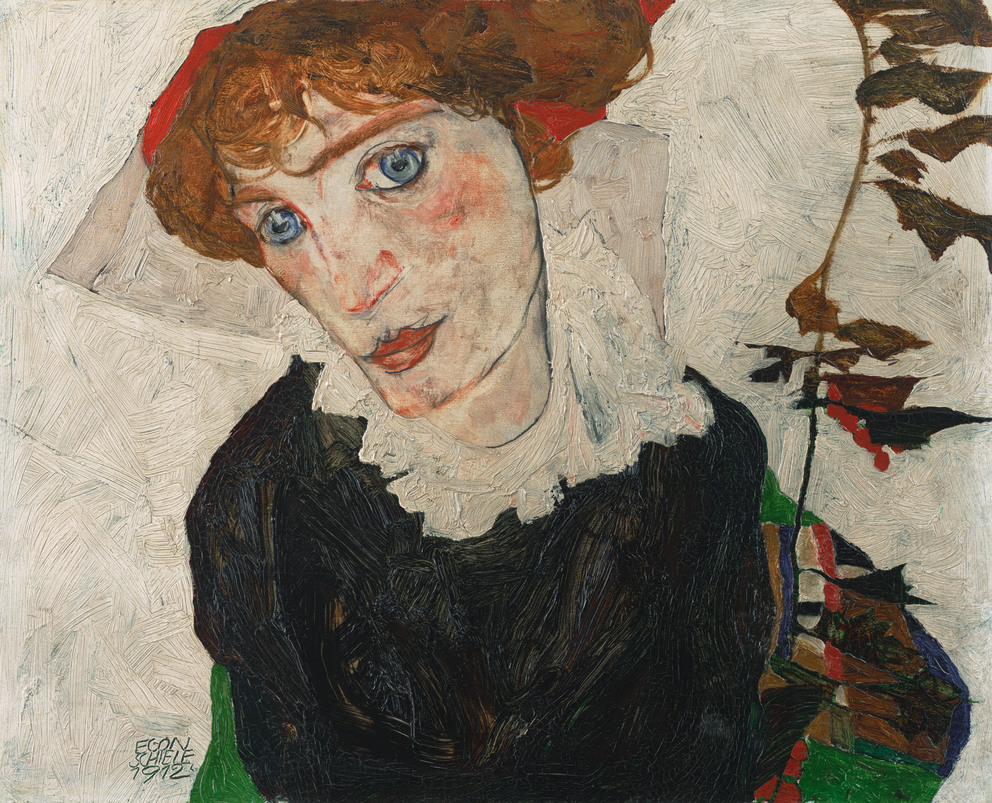
Vienna


Portrait of Wally Neuzil
1912
(Tulln 1890–1918 Vienna)
Egon Schiele (1890–1918) painted this portrait of his long-term partner Wally Neuzil (1894–1917), arguably her most widely known portrait, as a counterpart to his Self-Portrait with Chinese Lantern Plant. The half-length portrait in a horizontal format shows Neuzil with her head slightly inclined, with reddish-blond hair and oversized, sparkling blue eyes, gazing out of the picture with a serious expression. With its attention to basic geometric shapes and its harmonious combination of colors, the work skillfully balances tension and calm. The portrait exudes intimacy and tender affection and thus testifies to the close bond between the two lovers. Schiele and Neuzil remained in touch until the spring of 1915, even though the artist had turned to his future wife Edith Harms (1893–1918) already in 1914. Compared to the later full-length portraits of his wife, such as Edith Schiele in a Striped Dress, Sitting dating from 1915, the Portrait of Wally Neuzil is remarkable for its intimate format, in which Schiele depicts his partner almost close enough to touch. The horizontal format furthermore emphasizes the connection with his self-portrait, conceived as a counterpart, and therefore also the connection between the two subjects, whose emotional expressions complement each other in the compositions.
VG, 2022
Additional text according to Settlement, July 2010:
« Egon Schiele’s painting Portrait of Wally Neuzil was the personal property of Lea Bondi Jaray (1880–1969), a Jewish art dealer and owner of the Galerie Würthle in Vienna. After she was forced to turn the gallery over to art dealer Friedrich Welz in April 1938, Lea Bondi Jaray fled to London in 1939 to escape the Nazis. The Painting became the subject of court proceedings in New York City from 1998 to 2010, after it was loaned in 1997 to the Museum of Modern Art in New York by the Leopold Museum as part of an exhibition of Schiele works from the Leopold Museum’s collection. In 1999 the United States Government commenced a civil forfeiture action in New York, alleging that the Painting was stolen from Lea Bondi Jaray during the Nazi era by Friedrich Welz, and was imported into the United States in 1997 by the Leopold Museum in violation of U.S. law. The Estate of Lea Bondi Jaray asserted a claim to the Painting in the proceedings, and the U.S. Government agreed that upon forfeiture of the Painting, it would transfer to the Estate all right and title to the Painting.
Based on the evidence presented during the case, the United States District Court in New York concluded in 2009 that the Painting had been the personal property of Lea Bondi Jaray and that it was stolen from her in Vienna in the late 1930’s by Friedrich Welz, a member of NSDAP and Nazi collaborator, when he took over the Würthle Galerie from Lea Bondi Jaray as part of the “Aryanization” process. The Court found that the Painting had been seized from Welz by the U.S. Forces in Austria after the War and delivered in 1947 to the Austrian Federal Office for the Preservation of Historical Monuments (the „Bundesdenkmalamt“), along with paintings Welz had acquired from Heinrich Rieger, a Jewish art collector who was murdered in 1942 at the Theresienstadt concentration camp. In 1950 the Bundesdenkmalamt delivered artworks to an agent for the Rieger heirs and included Portrait of Wally Neuzil in the delivery. Later that year, the Rieger heirs sold their works to the Austrian National Gallery (the „Belvedere“), with Portrait of Wally Neuzil among these works. In 1954, the Belvedere traded the Painting to Rudolf Leopold. In 1994 Rudolf Leopold transferred the Painting to the Leopold Museum Private Foundation.
Following the Court’s findings on these issues, the case was finally resolved in 2010 by the U.S. Government, the Estate of Lea Bondi Jaray and the Leopold Museum. The Leopold Museum agreed to pay the Estate a substantial sum and, in return, the Estate agreed to release its claim to the Painting and the Government agreed to dismiss the civil forfeiture action and release the Painting to the Leopold Museum. »
If you have further information on this object, please contact us.
Emil Toepfer , Wien;
Richard Lanyi, Wien;
Lea Bondi Jaray, Wien (vor 1925-1939); (1)
Friedrich Welz, Salzburg (1939-1944); (2)
Salzburger Landesgalerie, Salzburg (1944-1945);
1945 Sicherstellung durch die US-Besatzungsmacht und 1947 Übergabe an das
Land Salzburg (3)
Dr. Robert Rieger und Tana Berger, New York (1948); (4)
Österreichische Galerie Belvedere, Wien (1950-1954); (5)
Dr. Rudolf Leopold, Wien (1954-1994); (6)
Leopold Museum Privatstiftung, Wien (seit 1994)
For provenance related information, please contact us.
2023/2024 Partial funding for digitization by the Federal Ministry for Arts, Culture, the Civil Service and Sport „Kulturerbe digital“ as part of NextGenerationEU.

